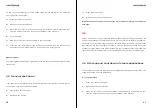
30
31
To begin the heat exchanger process, follow steps a–f, starting first on the cold side.
Then repeat for the hot side.
a)
Close the inlet shut-off valve.
b)
Open the outlet shut-off valve.
c)
Open the vent valve, if the heat exchanger is provided with one; otherwise vent
from the nearest vent valve to the heat exchanger in the pipework.
d)
Start the pump.
e)
Slowly open the inlet valve according to the instructions.
f)
Close the vent valve when all the air has been removed from the system. If the
heat exchanger is working properly, it can used on an ongoing basis.
Openable model:
When the openable model is being started up, always check the bolts and tighten them
if necessary.
4.3 General shut down
If the heat exchanger process is to be halted, follow steps a-d below, starting first on
the hot side. Then repeat for the cold side.
a)
Slowly close the inlet valves.
b)
Switch off the pumps.
c)
Close the outlet valves.
d)
Drain and vent the heat exchanger.
Gradually decrease the flow on the hot side until it stops completely. Then close the
cold side.
NB
Valves must be set to open gradually. Sudden opening and closing of the valves will
subject the exchanger to thermal shock and may cause material fatigue. In steam ap-
plications, never leave the hot side on when the liquid side is turned off. Turn the steam
OFF first and ON last. In steam processes, it must be noted that cooling water side
pressure must be higher than steam pressure in the condensate side controlled unit.
If pressure is lower, cooling water can evaporate and there is a risk of plate damage.
4.4 Start-up and shut down of steam applications
It is necessary to vent air off from the heat exchanger before starting the operation. The
following procedure should be followed:
Air venting process
1.
Close the inlet shut-off valve.
2.
Open the outlet shut-off valve.
3.
Open the vent valve, if the heat exchanger is provided with one; otherwise, vent
from the nearest vent valve to the heat exchanger in the pipeline.
















































